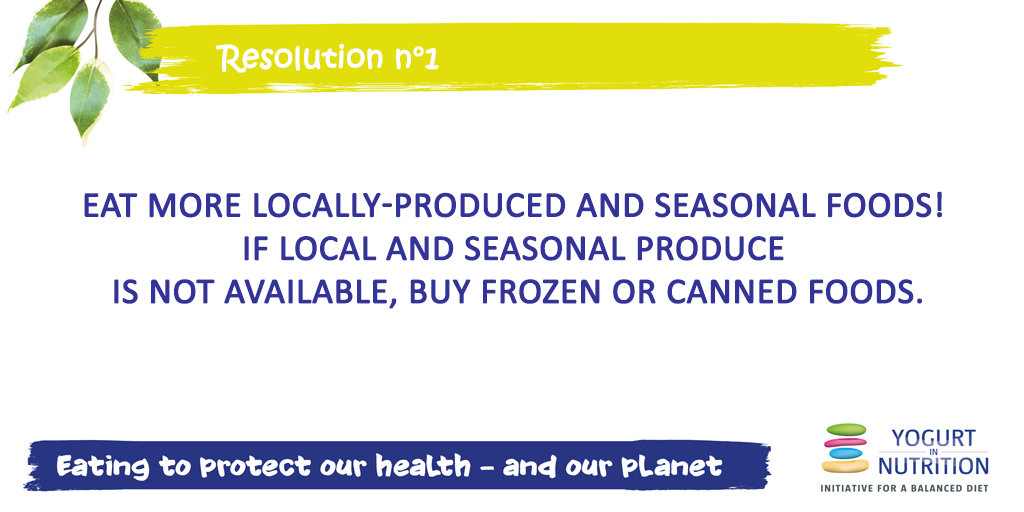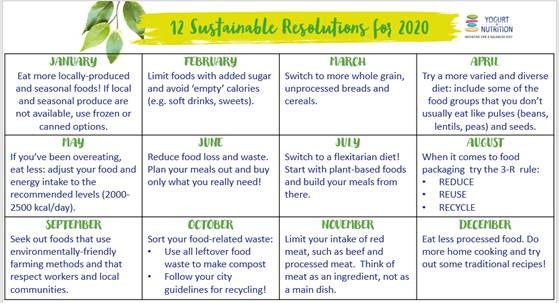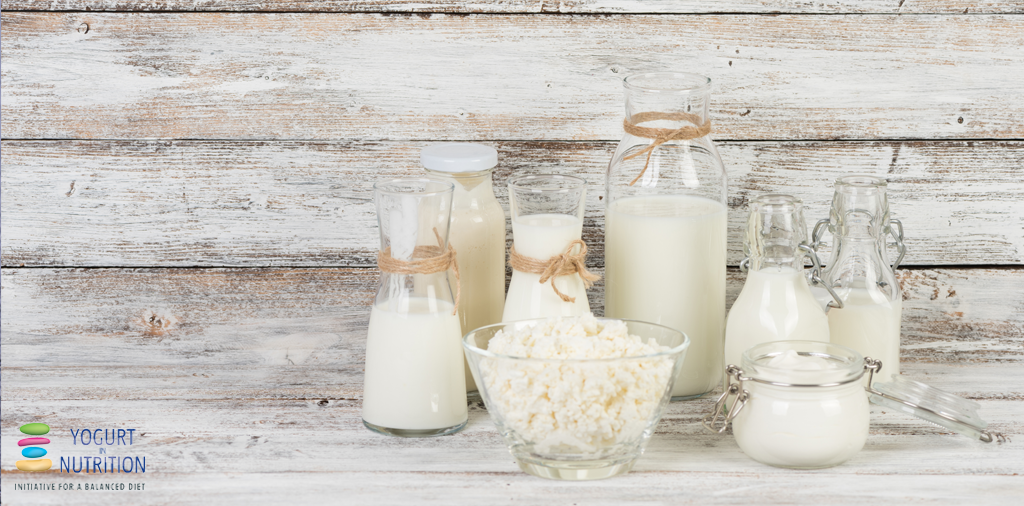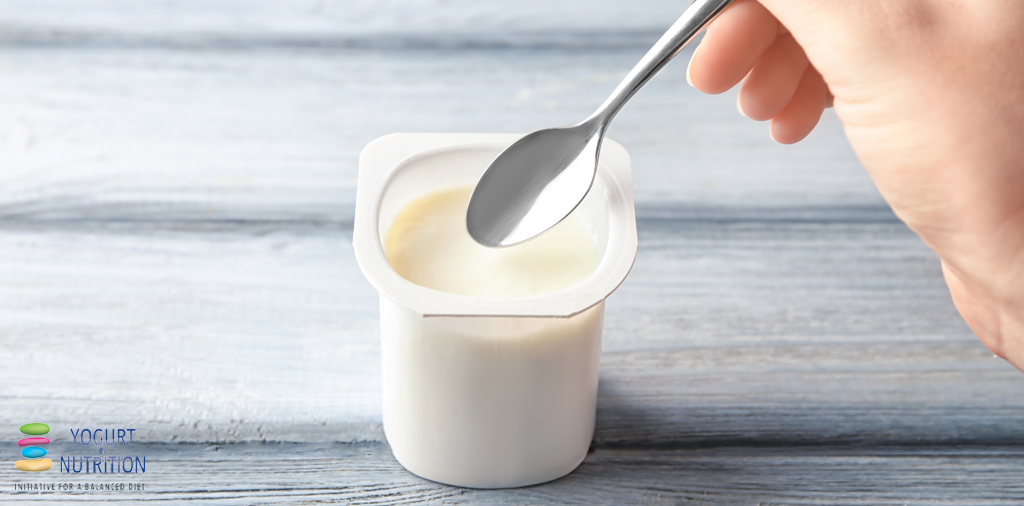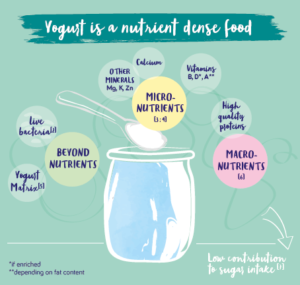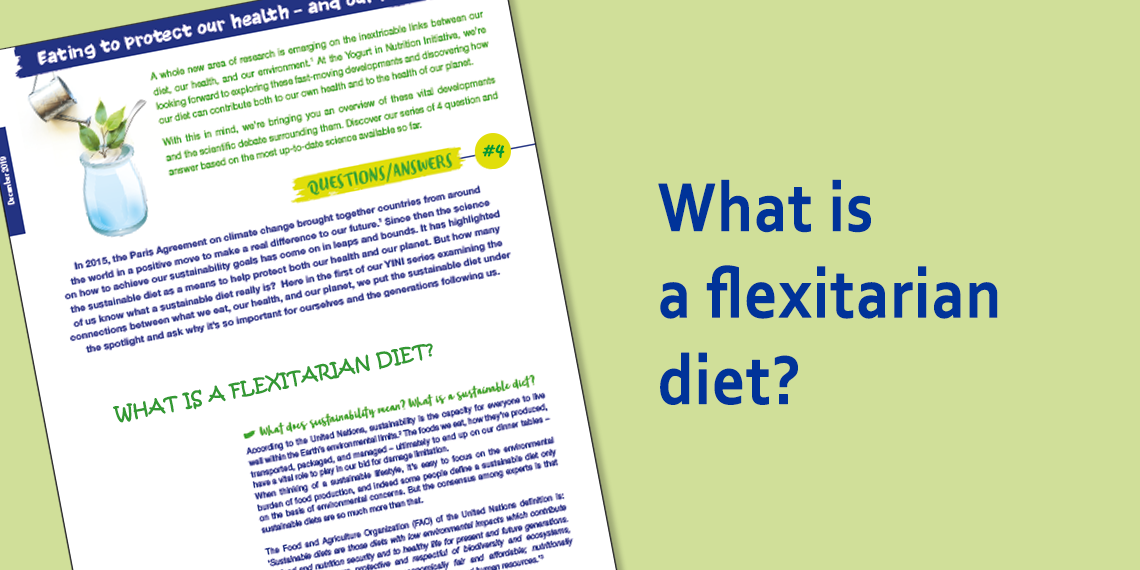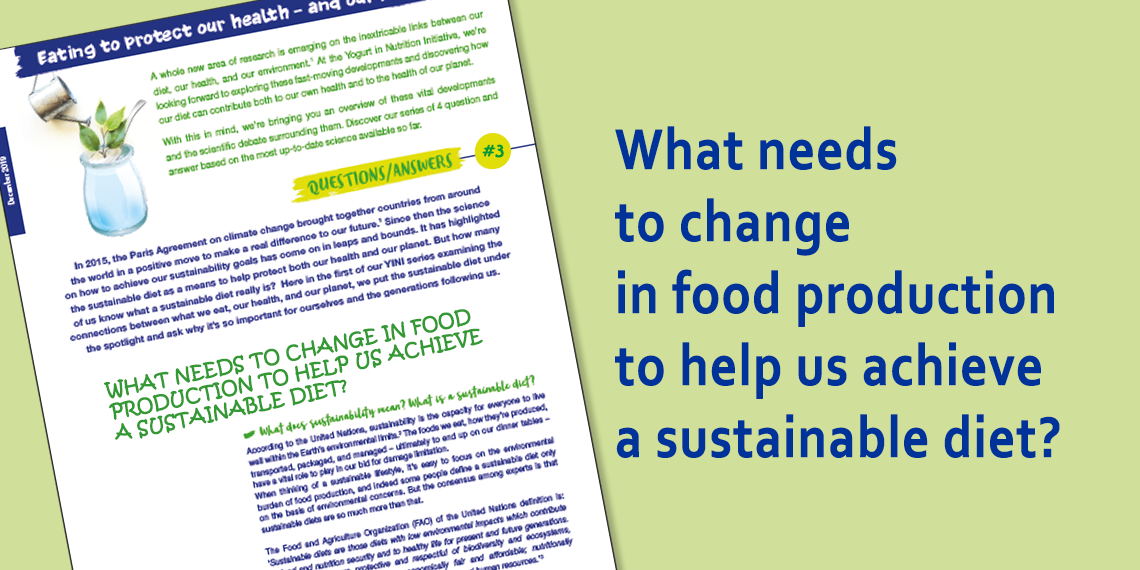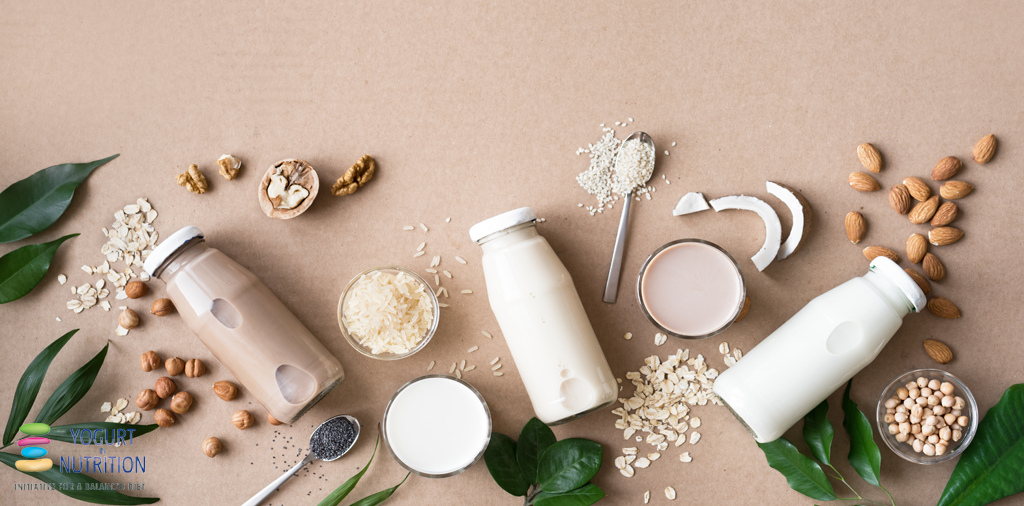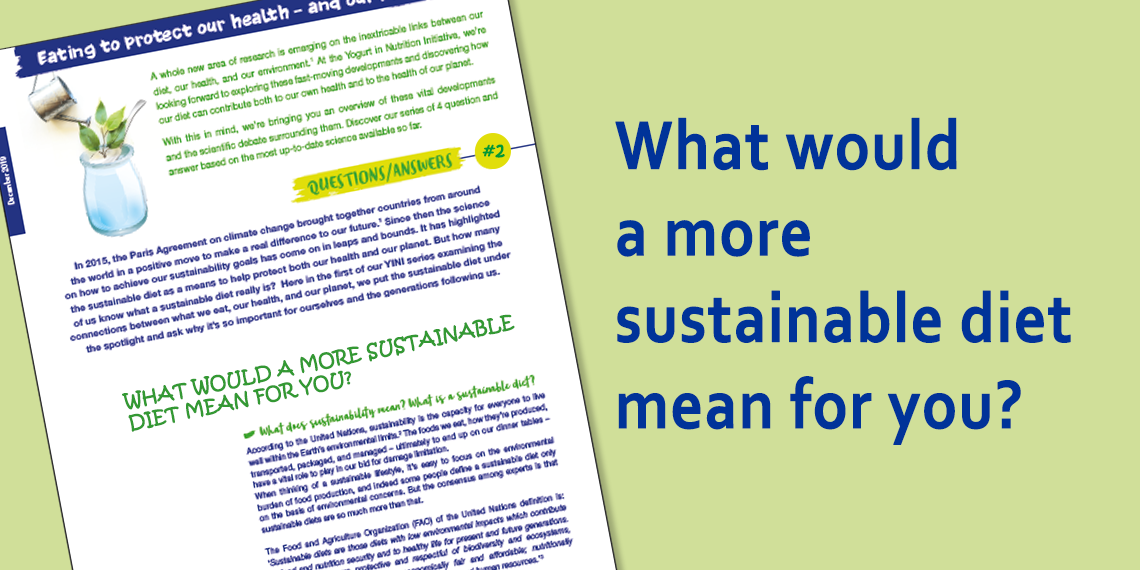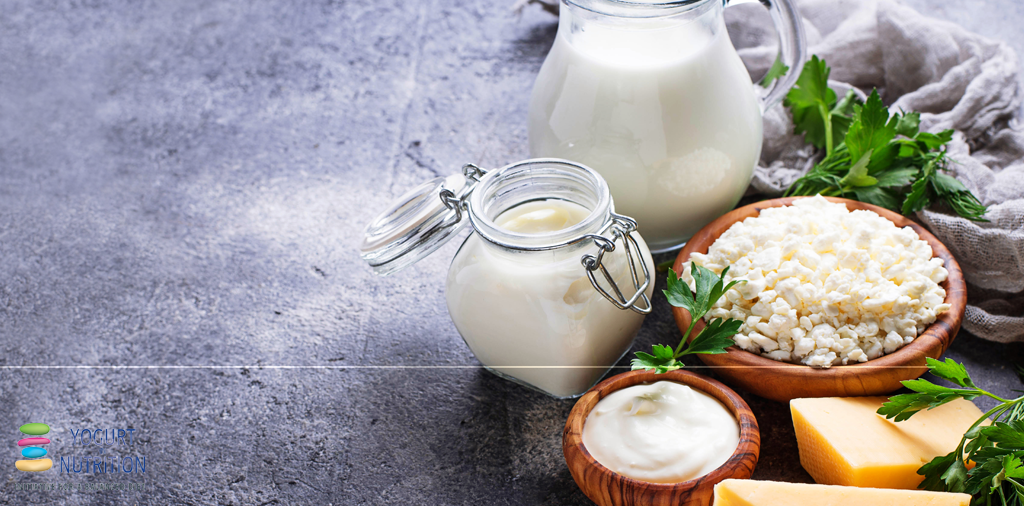Scientists are making major advances in understanding the links between diet, health, and environment. In this 2nd document of the Yogurt in Nutrition Initiative series exploring how our diet can contribute to our own health and that of our planet, we look at what it means to switch to a sustainable diet; the effects it could have on us and other people around the world. So whether you’re thinking of joining the sustainable food revolution or you just want to know what all the excitement is about, read on…
What would a more sustainable diet mean for you?
The environmental impact of the foods we eat varies widely according to the ways they’re grown, processed, transported, stored and thrown away (food waste). We can take a big step towards lowering our environmental impact, such as cutting greenhouse gas emissions, from our food system if we all make a shift in our everyday diet.1
That’s why a growing tide of people across the world is challenging the current food systems and diets and embarking on new paths that embrace a sustainable approach. They’re adopting a more environmentally-friendly diet, eating more plants and less meat, buying seasonal or local products – or producing their own food.
How could you make your diet more sustainable?
We don’t yet know the whole answer. Switching to a sustainable diet is not as straight-forward as it might seem. That’s because the environmental impact of our food system must be balanced against our need to eat a healthy diet that provides all the nutrients we need. Economics and society are also key pieces in the sustainability puzzle. Balancing the demands of all these different components is challenging and trade-offs may appear; for example, benefits to health could come at a cost to environmental outcomes.
So the question, ‘what’s best to eat?’ is leaving the world’s experts scratching their heads, and the hunt is on to find the most sustainable diets. Several pioneering studies have already helped to point the way to a ‘fresh start’ dietary lifestyle that could benefit both our health and our planet.2-6 As a result, we know there are steps we can take immediately to change our daily diet for the better.
Here’s what the evidence tells us so far…
Are you eating too much?
Over-eating – a common practice in the western world – is bad both for the environment and for health. So, a first and simple way to reduce the environmental footprint of the human diet in western countries would be to adjust our food and energy intake to recommended levels (2000-2500 kcal/day). Research has shown that people who eat too much can dramatically reduce their carbon emissions by cutting down to sensible levels of calorie intake.7 Reducing overweight in the population could also cut carbon costs relating to medical care needed to treat the complications of overweight and obesity – type 2 diabetes, for example
Should you cut down on animal products?
Several studies have looked at the environmental impact of various diets. The general conclusion has been that diets higher in plant-based foods and lower in animal products are better both for the environment and for our health.
As a result, the EAT-Lancet Commission recommends that, globally, people should eat more fruits, vegetables, legumes and nuts, and less red meat and added sugar.6 Other diet modelling studies have suggested that consumption of livestock products should be considered in the light of local circumstances (see below).
Reducing red meat and sugar consumption particularly applies to wealthier countries where people tend to eat too much of these food types. Elsewhere in the world, people have very different dietary needs.
‘Transformation to healthy diets by 2050 will require substantial dietary shifts. Global consumption of fruits, vegetables, nuts and legumes will have to double, and consumption of foods such as red meat and sugar will have to be reduced by more than 50%.’ – EAT-Lancet, 20196
Regardless of where you live in the world, a dilemma arises when identifying sustainable food systems because of the need to balance environmental impact with nutrition and health.
Animal products are responsible for most food-related climate emissions.8 Among them, red meat such as beef seems to put the biggest burden on the environment.7 Dairy products such as milk, however, have 5-times less environmental impact (shown by their associated greenhouse gas emissions and land use) than beef (per g protein). 9
One study in the Netherlands found that every household is responsible for 5.6 tons of carbon emissions each year, of which 1.8 tons are from meat and fish and 1.1 tons are from dairy and eggs compared with 0.5 tons from fruit and vegetables.7
One-quarter of the Earth’s landmass, excluding Antarctica, is used as pasture, and although some beef production uses native pasture, increasing beef production now relies on clearing forests and woody savannas.9
But livestock, especially dairy, is a major contributor to livelihood resilience across the world.10 Then there’s the nutritional value of these foods to consider.11 EAT-Lancet points out that especially for people living in poorer countries, meat, fish and dairy foods are vital sources of certain minerals and vitamins that they can’t get so easily from plant-based diets.6
By retaining dairy products in the diet, modelling studies find it easier to meet nutritional needs of the population than through plant-based foods alone. Research is trying to establish whether in some places the environmental cost of livestock is outweighed by its higher nutritional value, and how much the efficiency of livestock production can be improved, while reducing impact on the environment.
So, while EAT-Lancet gives global recommendations, it seems that an all-encompassing global approach doesn’t apply when it comes to sustainable diets. Other studies have modelled sustainable diets according to local or regional food production. Most studies so far agree on the need to shift towards more plant-based diets, but they differ on what the diets should be made up of, how much meat or dairy they should contain, and what kind of meat should be preferred, as these may depend of local issues.
For example, EAT-Lancet recommends keeping dairy consumption to below 250ml or one serving/day of milk on average (with a range 0-500ml/day).6 Some key studies that have modelled sustainable diets based on more environmentally-friendly livestock production have suggested diets with a higher intake of dairy products – up to 480ml/day of milk.2-5 Such diets allow consumers to benefit more from the nutrients provided by dairy products.
If animal-based diets and vegetarian diets both have their drawbacks, what is the alternative?
You can choose from several sustainable diet types — vegetarian (no meat) and vegan diets (no animal products) are not the only choices. Other types include pescatarian (replacing meat with fish), but the sustainable diet that’s likely to appeal to most of us is the flexitarian diet. Also known as semi-vegetarian, the flexitarian diet contains more plant-based foods than the diet that most people eat now in western countries but also includes small amounts of meat. As such, it promises to be a more flexible and versatile shift for non-vegetarians as it’s less restrictive in our choice of foods and doesn’t exclude any food type. It can also be adapted to a socio-cultural and personal preference while meeting nutritional and environmental needs. Hence it provides a practical and achievable way in which we as individuals can make a real difference to the environment.
But beware! When choosing your fruit, nuts and vegetables, don’t forget that the more exotic options may have to be imported, generating greenhouse gases through transport and distribution.7 So a banana imported to Europe from South America has a bigger carbon footprint than a locally-grown apple, for example. So, switching to more plant-based foods doesn’t automatically reduce your carbon footprint, and it can make it even bigger, one modelling study found.7
Choosing fruit and vegetables that are in season is also important for cutting down on greenhouse gases arising through transport and distribution. So if you live in northern Europe, that means no tomatoes in winter!
It’s not just about greenhouse gases. Another hidden danger that can trip you up on your path to sustainability is unexpected use of natural resources. For example, nuts are widely recommended by EAT-Lancet and other dietary modelling studies, but some nuts can have their down-side too. It’s estimated that for an almond tree to grow one almond, it needs to guzzle one gallon of water!12
‘The sustainable principle to eat less animal-based products and more plant-based products does not automatically result in a more environmentally-friendly diet.’ – van Est L et al, 20177
Are diets that are good for the planet also good for our health?
Diets that are high in plant-based foods and low in meat have been shown to have a lower environmental impact, and generally this matches health experts’ advice too.
The EAT-Lancet Commission found that changes from current diets toward healthy plan-rich diets are likely to result in major health benefits.6
So overall, changing what and how much we eat is a win-win opportunity to improve both our health and that of the planet.
Scientists are yet to conclude exactly what constitutes a healthy sustainable diet and food production system, but nutritionally it’s stands to reason that the flexitarian diet is likely to hold some advantages over vegan and vegetarian diets.
That’s because humans have evolved as omnivores and so vegans and vegetarians need to compensate for the nutrients that they’d otherwise get through eating animal products. Such diets can therefore increase the risk of some nutritional deficiencies and health concerns, especially for groups with specific nutritional needs such as teenagers, pregnant women, the elderly or people with specific chronic diseases. So if you follow a vegan diet, you’re more likely than others to have a lower impact on the environment, but you’re also more likely to need to take specific nutritional supplements. Not much is known about the environmental footprint of such supplements which may generate carbon emissions through their extraction, production, and packaging.
In a flexitarian diet, the high amount of plant-based foods and low amount of sugar and meat generally provides all-round healthy nutrition. See more about flexitarian diets.
‘If an individual decides not to eat certain animal products based on environmental concerns, they must make sure that their new diet still lowers their environmental footprint.’ van Est L et al, 20177
It’s not a ‘one size fits all’ when it comes to determining what constitutes the best diets around the world. In some countries healthy and sustainable diets should be designed to reduce hunger and under-nutrition, while in other countries they should address the risk of obesity and associated chronic diseases. Such issues make it all the more complicated for experts to predict how changes to diets will impact on our health.
In one diet-modelling study in which some or all of the animal-source foods were replaced with plant-based foods, the new diet was particularly effective in high-income countries for improving nutrient levels. In these countries, it was also associated with reductions in early deaths by up to 12%, and it cut greenhouse gas emissions by up to 84%.13 But it seemed to have little effect in countries with low or moderate consumption of animal-source foods, generally those countries that have a low income level.
Can yogurt and other dairy products be part of a sustainable diet?
Dairy products – such as milk, yogurt, and cheese -can play an important role in sustainable diets.
Not only is dairy a nutrient-rich food, it also has a lower environmental footprint than beef. Many studies on sustainable diets include dairy products2-5,13 because of their nutrient density, the role that ruminants can play in making use of grass biomass and the role that dairy products play in many current diets.14-16
As well as their high-quality proteins, dairy products contain high amounts of calcium, iodine, magnesium, and vitamins such as vitamin B2 and B12. The package of nutrients makes dairy products a key contributor to meeting nutritional needs. So it comes as no surprise that they’re recommended on a daily basis by almost all food-based dietary guidelines to achieve healthy diets.
Dairy consumption has also repeatedly been shown to benefit health.
Among dairy products, yogurt and other fermented milks in particular are associated with many health benefits beyond nutrition. Regular yogurt consumption is associated with improved diet quality, improved nutritional intakes, improved weight management and a reduced risk of several chronic diseases such as type 2 diabetes.17 Probiotic organisms in yogurts are associated with further benefits such as improved digestive health. And these live microorganisms in yogurt also make it easy to digest by people with lactose intolerance.
What would be the effect on the environment of cutting out dairy products from the diet?
The high nutritional content of dairy products explains why they tend to be included in models of sustainable diets. Excluding them from the diet leaves a gap that can be hard to fill.
This was demonstrated by a modelling study that looked at the effect of cutting out entire animal food groups from the diet, the model calculating an alternative diet that meets all nutrient requirements.7 Results revealed that avoiding all dairy products hardly changed the environmental footprint, while according to the model, avoiding meat cut carbon emissions by a quarter.
As the researchers explained, to get the equivalent nutrients that you would get from dairy products, you’d need to eat much more fruit and vegetables before you could reach the recommended daily amounts – mounds of spinach to replace the calcium, for example, making it an unrealistic alternative. When you add up the environmental effects of the replacements, you get roughly the same environmental effect as if you’d stuck with your dairy products.
What about plant-based yogurts?
Fortified plant-based products such as soya drinks and yogurt alternatives can complement or substitute dairy, while having an even lower environmental impact. The carbon footprint of protein from soy drinks is about 3 times lower than that of milk, while requiring 10 times less land.9,18 However, research shows that plant-based milk alternatives can’t beat cow’s milk products for nutritional value. For example, while plant milks fortified with calcium may contain similar amounts of calcium to cow’s milk, we may not be able to absorb calcium from plant milks as readily as the calcium found naturally in cow’s milk.19 This needs to be studied further.
Summing up – what does the evidence tell us so far?
Research is working towards identifying the diets that meet all the demands of sustainability, including limiting environmental burden while covering our nutritional needs. These include nutrients for healthy growth and strong bones in childhood and for preventing non communicable diseases. While waiting for the scientists to come up with the answers, there are steps you can take now to help your health and the planet:
- If you eat too much – eat less
- Eat more fruit, nuts and seeds, and vegetables
- Eat a limited amount of red meat such as beef (if you live in a westernised country)
- Eat less processed food especially processed meat
- Limit foods with added sugar and avoid those that are ‘empty’ calories (e.g. soft drinks, sweets)
- Eat more locally-produced and seasonal foods
Find out more:
Sources:
- Perignon M, Masset G, Ferrari G, et al. How low can dietary greenhouse gas emissions be reduced without impairing nutritional adequacy, affordability and acceptability of the diet? A modelling study to guide sustainable food choices. Public Health Nutr. 2016Oct;19(14):2662-74.
- WWF France. Towards a low carbon, healthy and affordable diet. 2018
- WWF (UK). Eating for two degrees. 2017
- Poux X, Aubert PM: IDDRI. An agroecological Europe: a desirable, credible option to address food and environmental challenges. 2018
- Karlsson JO, Carlsson G & Lindberg M, et al. Designing a future food vision for the Nordics through a participatory modeling approach. Agronomy for Sustainable Development. 2018;38:59
- Willett W, Rockström J, Loken B, et al. EAT-Lancet Commission Summary report: Food in the anthropocene: the EAT–Lancet Commission on healthy diets from sustainable food systems. Lancet. 2019;393(10170):447-492
- van Est L, Blom L, Peters S. Decreasing the environmental footprint of our diet – wrong paradigm? ‘Less animal more plant-based’. Translation from: Voeding Magazine. 2017:p15-22.
- Food and Agriculture Organization of the United Nations. Dairy Development’s Impact on Poverty Reduction. 2018
- World Resources Institute. Ranganathan J, Vennard D, Waite R et al. Working paper: Shifting diets for a sustainable food future. 2016
- Food and Agriculture Organization of the United Nations. Dairy Development’s Impact on Poverty Reduction. 2018
- Drewnowski A; Ecosystem Inception Team. The Chicago Consensus on sustainable food systems science. Front Nutr. 2018 Apr 25;4:74.
- Mekonnen M M, Hoekstra AY. The green, blue and grey water footprint of crops and derived crop products. Hydrology and Earth System Sciences, 2011;15(5):1577-1600.
- Springmann M, Wiebe K, Mason-D’Croz D, et al. Health and nutritional aspects of sustainable diet strategies and their association with environmental impacts: The Lancet Planetary Health. 2018
- Food and Agriculture Organization of the United Nations. Dietary protein quality evaluation in human nutrition. 2011
- van Hooijdonk T, Hettinga K. Dairy in a sustainable diet: a question of balance. Nutrition reviews. 2015; 73(suppl_1):48-54
- Interview with Professor T van Hooijdonk
- Marette A, Picard-Deland E, Fernandez MA. Yogurt: roles in nutrition & impact on health. CRC press. CRC Press. 2017
- Poore J, Nemecek T. Reducing food’s environmental impacts through producers and consumers. Science 2018;360:987–992.
- Chalupa-Krebzdak S, Long CJ, Bohrer BM. Nutrient density and nutritional value of milk and plant-based milk alternatives. International Dairy Journal. 2018;87:84-92.
